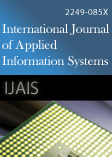
- Seema Shah 2012. Students are Best Judge of Teaching & Learning: A Case study of Technical Institutes of India. International Journal of Applied Information Systems. 3, 1 (July 2012), 34-37. DOI=http://dx.doi.org/10.5120/ijais450436
-
@article{10.5120/ijais2017451568, author = {Seema Shah}, title = {Students are Best Judge of Teaching & Learning: A Case study of Technical Institutes of India}, journal = {International Journal of Applied Information Systems}, issue_date = {July 2012}, volume = {3}, number = {}, month = {July}, year = {2012}, issn = {}, pages = {34-37}, numpages = {}, url = {/archives/volume3/number1/198-0436}, doi = { http:/ijais12-450436}, publisher = { xA9 2010 by IJAIS Journal}, address = {} } -
%1 450436 %A Seema Shah %T Students are Best Judge of Teaching & Learning: A Case study of Technical Institutes of India %J International Journal of Applied Information Systems %@ %V 3 %N %P 34-37 %D 2012 %I xA9 2010 by IJAIS Journal
Abstract
This paper proposes fusion and addition techniques of vocal tract features such as Mel Frequency Cepstral Coefficients (MFCC) and Dynamic Mel Frequency Cepstral Coefficients (DMFCC) in speaker identification. Feature extraction plays an important role as a front end processing block in Speaker Identification (SI) process. Mel frequency features are used to extract the spectral characteristics of the speech such as formant frequency and the bandwidth of formant frequency. This feature estimation method leads to robust recognition performance. The Dynamic Mel frequency features are used to extract the dynamic behavior of the human vocal tract using pitch frequency. This work is focused to increase the identification accuracy with databases containing short length speech signal. Experimental evaluation is carried out on TIMIT database with 630 speakers using Gaussian Mixture Model (GMM).
References
- Seema Shah, J. N. Mishra (2008) "Perspective Statistical Analysis of Officers of Technical Education in India" International Journal of Computer Science and Network Security, Vol. 8, No. 12 pp. 355-360.
- Seema Shah (2010) "Best Practices in Teaching and Learning of Technical Institutes in India", International Journal of Engineering and Technology, Vol. 2, No. 4 pp. 374-378.
- Seema Shah (2011) "Impact of IT Techniques on Human Resource Management in Technical Institutes of India" International Journal of Computer Applications (0975-8887) Vol. 21-No. 1,May 2011, pp. 46-50.
- Seema Shah (2011) "Management Education in India: A Global Perspective" International Conference on Business and Information (BAI), ISSN: 1729-9322, July 4-6, 2011.
- Hills, H. R (1979): Teaching and training: A handbook for instructors. London: Macmillan Publishers.
- Lewis, M (2010). The University of Sheffield library information commons: A case study, Journal of Library Administration,50 (2),161-178.
- Ughamadu, K. A and Onyemerekeya, C. C (1998): Characteristics of good teacher, in K. A, Ughamadu and N. S Okoye (eds) principles, methods and strategies for effective Teaching. Onitsha/Aghor Kmenbuon Educational Publishers.
- Trentin, G. (200(. "Using a wiki to Evaluate individual contribution to a collaborative learning project", Journal of Computer Assisted Learning 25:43-55.
- Cohen, R. (1993) "The use of voice synthesizer in the discovery of the written language by young children. Computers and Education, 21 (1/2), 25-30.
- Campbell, M. (2009b) Using virtual world technologies to improve the professional decision-making capacities of pre-graduate teachers.
- Fortin MG (2000), Faculty use of the World Wide Web: Modeling information seeking behavior in a digital environment, PhD thesis, University of North Texas, Denton, Texas.
- Rae, R. (2004) Where, when and how do university students acquire their ICT skills? The Internet and Higher Education, (3-4), 1-12.
- Bold, M. (2006) "Use of wikis in graduate course work", Journal of Interactive Learning Research 17 (1): 5-14.
- Kumar R, Kaur A (2006). Internet use by teachers and students in engineering colleges of Punjab, Haryana and Himachal Pradesh States of India: An analysis. Elect. J. Acad. Spec. Librarianship. 7 (1): 1-13.
- Churchill, D. (2007). "Web 2. 0 and Possibilities for Educational Applications. " Educational Technology 47 (2): 24-29.
- Hara, N. and King, R. (2000) Students distress with a web-based distance education course: an ethnographic study of participants experiences (CSE Working Paper). Indiana: Centra for Social Informatics, Indiana University.
- Yelland, N. (1999) Reconceptualising school with technology for the 21st century Information Technology in Childhood Education , 12 (1). 39-59.
- Teo,T. (2008). Assessing the computer attitudes of students: An Asian perspective. Computer in Human Behavior, 24, 1634-1642.
- Wood. D. (2010). Communicating in virtual worlds through a Web 2. 0 application. Telecommunications Journal of Australia, 60 (2), Monash University Press, 19. 1-19. 16.
- Jamieson P (2009). The serious matter of informal learning. Planning for Higher Education, 37 (2), 18-25.
Keywords
Institutes, Students, Case Studies, Teaching & Learning, Punctuality, Clarity Of Expression, Communication, Courses And Classes
 http:/ijais12-450436
http:/ijais12-450436
